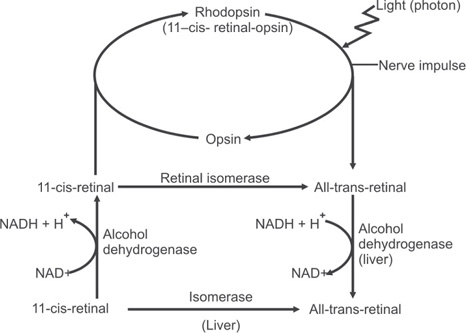Vitamin - A
Introduction to Vitamin:
- Vitamin may be defined as organic compounds occurring in small quantities in different natural foods and necessary for growth and maintenance of good health in human beings and in experimental animals.
- Vitamins are essential food factors, which are required for the proper utilization of the proximate principles of food like carbohydrates, lipids and proteins.
- All the vitamins are usually available in an ordinary Indian diet.
The vitamins are mainly classified in to two:
1. The fat soluble vitamins are A,D,E and K
2. Water soluble vitamins are B complex and C .
Vitamin A:
- It is a fat soluble. The active form is present only in animal tissues.
- The pro-vitamin, beta - carotene is present in plant tissues. One molecule of beta-carotene can theoretically give rise to two molecules of vitamin A.
- Vitamin A has a beta- ionone (cyclohexenyl) ring system.
- Three different compounds with vitamin A activity are retinol (vit.A alcohol), retinal (vit A aldehyde) and retinoic acid.
- The retinal may be reduced to retinol by retinal reductase. This reaction is readily reversible.Retinal oxidized to retinoic acid, which cannot be converted back to the other forms.
- The side chain contains alternate double bonds, and hence many isomers are possible. The all- trans variety of retinal, also called vitamin A1 is most common.
- Biologically important compound is 11- cis-retinal.
Absorption of vitamin A:
- The absorption is along with other fats and requires bile salts. In biliary tract obstruction and steatorrhea, vitamin A absorption is reduced.
- It is carried by chylomicrons and transported to liver. In the liver cells, vitamin is stored as retinol palmitate.
Transport from Liver to Tissues:
- The vitamin A from liver is transported to peripheral tissues as trans-retinol by the Retinol Binding Protein or RBP.
Uptake by Tissues:
- Inside the cytoplasm of cells, vitamins bends to Cellular Retinoic acid Binding Protein (CRBP) and finally to Hormone Responsive Element (HRE) of DNA. Thus genes are activated.
Biochemical role of vitamin A:
A. Wald's visual cycle needs 11 Cis- retinal.
B. Regeneration if 11-cis - retinal.
Dark adaptation mechanism:
- Bright light depletes stores of rhodops in rods. Therefore when a person shifts suddenly from bright light to dimly light area, there is difficulty in seeing, For example - entering a cinema theater.
- After a few minutes, rhodopsin is re-synthesized and vision is improved. This period is called dark adaptation time.
It is increased in vitamin A deficiency. Red light bleaches rhodopsin to a lesser extent, so doctor use red glasses , during fluoroscopic X-ray examination of the patients.
Rods are for vision in dim Light.
Cons are for color vision.
Biochemical functions of vitamin A:
- Retinal is the active form required for normal vision.
- Retinoic acid is implicated in growth and differentiation of tissues.
- Retinol is necessary for normal reproduction. In vitamin deficiency, miscarriages are noticed in female rats while atropy of germinal epithelium and sterility are seen in male rats.
- Anti- oxidant property: Fresh vegetables containing carotenoids were shown to reduce the incident of cancer.
Deficiency manisfestation of vitamin A:
1. Night blindness:(Nyctalopia)- Visual acuity is diminished in dim light. The patient cannot read or drive a car in poor light. The dark adaptation time is increased.
2. Xerophthalmia: The conjunctiva becomes dry thick and wrinkled.
2. Xerophthalmia: The conjunctiva becomes dry thick and wrinkled.
3. Bitot's spots: These are seen as grayish - white triangular plaques firmly adherent to the conjunctiva.
4. Keratomalacia: When the xerophthalmia persists for a long time, it progresses to Keratomalacia (softning of the cornea).
5. Preventable Blindness: The deficiency of vitamin A is the most common cause of blindness in india children below the age of 5.
6. Skin and Mucous membrane lesion: Hyperkeratosis, The alteration in skin may cause increased occurance of generalized infections.
Cause for Vitamin A deficiency:
- Decreased intake
- Obstructive jaundice causing defective absorption.
- Chronic nephrosis, where RBP is excreted through urine.
Dietary source of Vitamin A:
Animal source: Milk, Butter, Cream, Cheese, Egg yolk and liver
Fish liver oils are very rich sources of the vitamin.
Vegetable sources: Yellow pigmented beta carotene. Carrot, Papaya, Mango, Pumpkins, Green leafy vegetable.
Daily Requirements of vitamin A:
The recommended daily allowance (RDA):
1. Children = 400 - 600 microgram/day
2. Men = 750-1000 microgram/day
3. Women = 750 microgram/day
4. Pregnancy = 1000 microgram/ day
Hypervitaminosis Vitaminosis A:
- Excessive intake can leads to toxicity since the vitamin is stored.
- Symptoms of toxicity include anorexia, irritability, headache, peeling of skin, drowsiness and vomiting.
- Enlargement of liver is also seen in children.
Follow me on social website:
Blogger Website: http://www.mltclinicalnotes.blogspot.com
Facebook Page: https://www.facebook.com/mltclinicalnotes
Instagram: https://www.instagram.com/mltclinicalnotes
YouTube Channel: https://www.youtube.com/mltclinicalnotes











Comments
Post a Comment
If you have any doubts, please let me know.